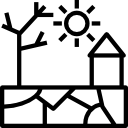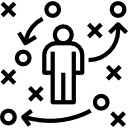INFORMATION AREAS
Man and the environment 
Man is an immediate part throughout his development. In the past, man has adapted to the environment. With a gradual technical boom, he began to change the environment to his needs. The scale of the changes has been and still is enormous and disturbs the ecosystem and the ecological balance of the environment. Are you interested in the topic of the environment or do you just want to learn something new, open an article and you will find various interesting things there.
What will you know?
WHAT THE MAN MEANS: Man is a bio-psycho-social being.
WHAT THE ENVIRONMENT IS: The environment is a space in which a person is exposed to various influences. Everything that creates natural conditions for the existence of organisms, including humans, and is a prerequisite for their further development.
WHAT CREATES THE ENVIRONMENT: Its components are mainly air, water, rocks, soil and the organisms themselves.
DIVISION OF THE ENVIRONMENT: We can divide the environment from several points of view. One of them is how they originated and the other is the aspect of the predominant tasks that the environment fulfills for the human being within the environment.
WHAT ARE THE NEGATIVE EFFECTS ON THE ENVIRONMENT: According to the WHO, human diseases can be prevented through a healthy environment.
WHAT THE ECOLOGY IS: It is a biological science that studies the environment of animals and plants. It examines the relationships between organisms and the environment in which they live.
WHAT AN ENVIRONMENTALISTICS IS: It is a science that deals mainly with the issue of the human environment. It solves, for example, the problems of waste treatment, diseases of civilization, protection of historical monuments and the like.
Quote
"Mosquitoes have disappeared, there are fewer and fewer birds and fish. In the end, we created such an environment in which only a person can live. ”- Dušan Radovič Serbian poet
What will it bring you?
- Better understanding of basic environmental concepts.
- Knowledge in the field.
- You will get an overview of the division and components that make up the environment.
- You will have knowledge of how to behave to improve the environment and what consequences this can have if you do not follow certain rules.
How about a little professionally?
Man is a bio - psycho - social being, the following parts are a part of this whole:
Biological being - man with his bodily system is a part of living nature, he is an organism.
Psychological being - man is a subject, a being who can know and change the world and himself.
Social being - a person lives his whole life in a network of relationships with other people.
Human health and well-being are closely linked to the state of the environment.
Organic and inorganic environmental components:
1. Inorganic, ie inanimate components
- hydrosphere - water and without it we can last 6 days
- pedosphere - the soil from which we get up to 64% of food
- atmosphere - the atmosphere without which we can last 3 minutes
- The lithosphere is a bedrock.
2. Organic, ie living ingredients
- biosphere organisms
Environmental division:
in terms of origin:
- Natural environment - ie organic and inorganic.
- Artificial environment - anthropogenic is what nature did not create itself, but it was created by humanity during its development.
- Social environment - it arises on the basis of interactions (the spiritual world of man and the network of relationships between people, which arose in the historical process of human development).
in terms of functions:
- Working,
- Residential,
- Recreational.
Negative effects on the environment:
An unfavorable environment results in more than 18% of the deaths in Europe.
Environmental pollution has an extremely negative impact on global climate change. The result of these changes is:
- The change in air temperature, the latest analyzes confirm the fact that the global air temperature has increased by 0.8 ° C in the last almost 160 years. In addition to the global increase in air temperature, the polar regions in particular are heating up significantly.
- Heat and drought, heat waves and rising temperature records every year result in enormous water losses.
- Floods are increasing, especially in Central Europe, and are caused by unusually long periods of rain.
- Sea level rise over the last 100 years by 10 to 25 cm.
- Reducing the supply of water resources The synergistic effect of the decrease in atmospheric precipitation and the increase in temperature disrupts the natural water cycle. Local increases in water content during torrential rains are temporary and watercourses will be significantly reduced, especially during the spring and summer months. This means a negative impact on the biodiversity of river and stream ecosystems.
- The change of forest communities and the threat to forest biodiversity will be caused by climate change, by 2075 the shift of vegetation zones by 200 to 300 km to the north, resp. by 150 to 300 m to higher positions. Extensive changes are expected in forest communities, especially in Slovakia.
Many ecological and environmental activities and strategic documents aimed at promoting climate change and recovery, including at European level, have emerged to halt the unfavorable climate change situation.






